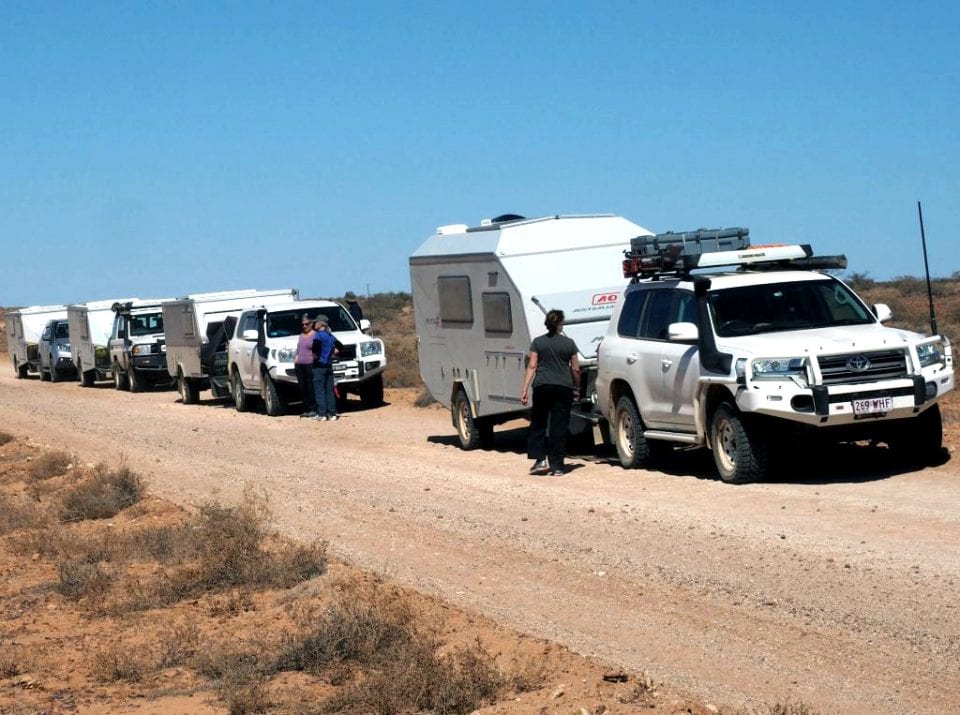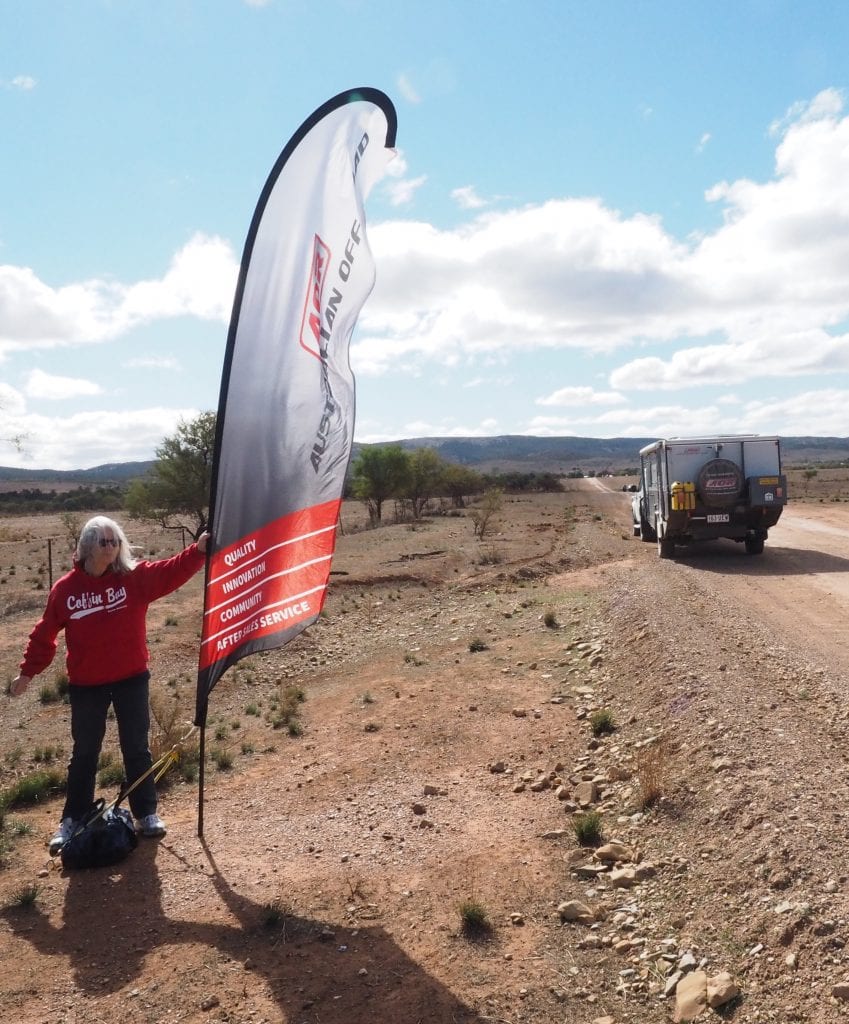 Getting together with a group of people you have never met can be a daunting experience but all being owners of an AOR camper seems to be an excellent starting point for an adventure. We started as a group of like-minded owners and ended up as a group of great friends brought together by the shared fun and experiences we had over the 12 days of the event.
Getting together with a group of people you have never met can be a daunting experience but all being owners of an AOR camper seems to be an excellent starting point for an adventure. We started as a group of like-minded owners and ended up as a group of great friends brought together by the shared fun and experiences we had over the 12 days of the event.
The SA rally was run as a ‘progressive’ event moving location every two days. This goal was to provide everyone with opportunities to taste the Flinders Ranges. The ‘taste test’ hopefully will encourage them and other AOR owners to return to this diverse and fascinating piece of outback South Australia. Moving any sizable group can offer up its own unique challenges so we limited the numbers for everyone’s safety and sanity and provided detailed pace notes for each move which gave everyone the confidence and time to explore many things on each leg of the journey. It also allowed folk to travel either singly or in small groups and as the majority of the transit sections were all on outback dirt tracks this also reduced the dust and made travel safe and comfortable for all involved.
This was the trip of the multiple Ians so if we couldn’t remember a name we called him Ian and most times we were right! A group of 27 like-minded participants in 13 campers left a rather cold and damp Clare heading north into the teeth of a howling gale blowing more than 60 km/h. Fuel consumption was a talking point on the UHF with all vehicles using around 20% more than usual thus making for some unscheduled fuel stops on our way to Bendleby Ranges. The pace notes must have worked as everyone began arriving at the property around the agreed time. After settling in the consensus was it was too wet and windy to have a fire and sadly the drive up to sunset ridge was ruled out for the same reasons. The following day was spent exploring the property, chatting to other campers and/or just relaxing. The camp kitchen’s dining area allowed us all to share a drink and meal together out of the elements. Weather reports did not offer hope of accomplishing much unless it was from the inside of a 4WD. Undeterred, Pauline took the ladies for a walking tour around a nearby walking track and Steve from RedArc ran a series of sessions on all things 12 volt and RedArc. The end result of this was him commencing a series of ‘house’ calls to individual campers and owners. After lunch we took everyone out to explore some of the 4WD tracks on the property. Once back at camp we managed to get a fire going for all to enjoy.
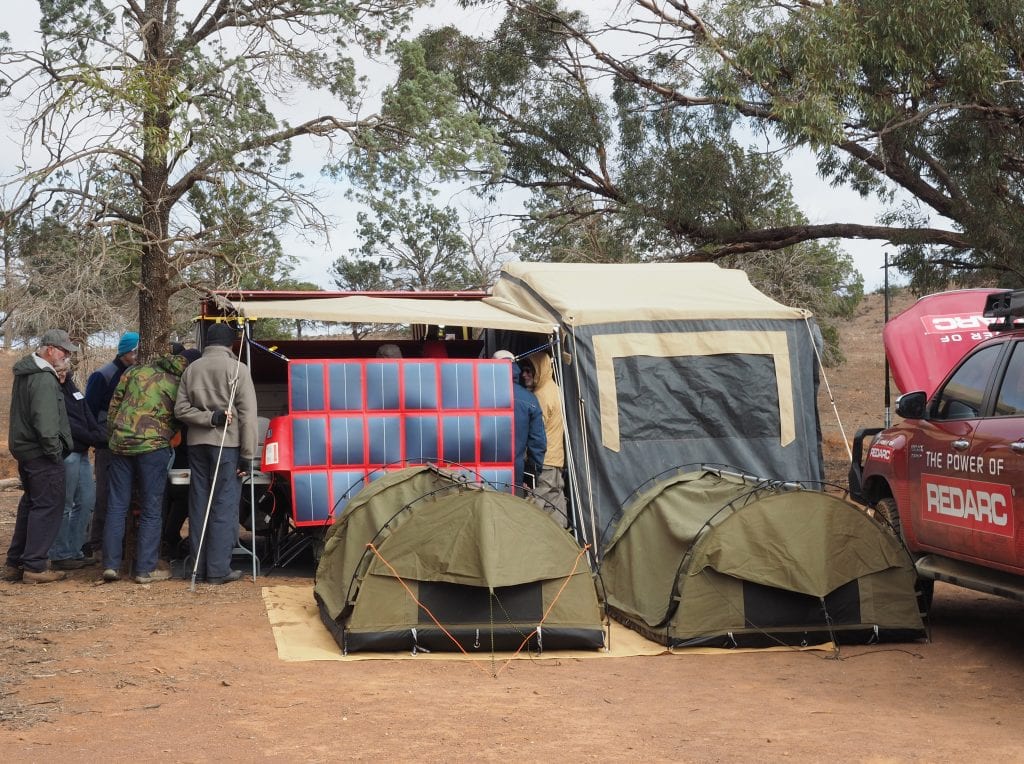
Our second transit was to Rawnsley Park Station in the Flinders Ranges and via Hawker. Again the detailed pace notes allowed everyone to take their time as the weather had begun to lift along with our spirits. There were several Kodak moments along the way.
Our camping area at Rawnsley Park was cut into the side of a hill which gave us some great views towards Rawnsley bluff and the Chace range. Ian and Madelaine Baker volunteered to act as ‘sweep’ today and were rewarded with the best site offering clear views to some great Flinders Ranges vistas. The weather was on the improve but cold, so a cunning plan was formed to use the remaining level campsite as the fire pit cum meeting area for the duration of our stay. Several owners had varying forms of portable fire pits and after some wine-inspired discussion it was decided to establish, once and for all, if there was any difference between cooking with charcoal or wood. The details are already lost in the mist of time but a synopsis goes something like this. Charcoal was quicker to generate heat and get the fire to the stage where you could cook on it as well as providing more consistent heat for longer. Wood took a lot longer; we had cooked a meal on the charcoal-powered one by the time the timber had got to suitable coals but most agreed that watching the flames in the wood fire was a nice thing. Outcome is, if you want to watch a fire, use wood; but if you want to cook and keep warm, charcoal offers a great alternative.

The following day everyone went out exploring the Flinders Ranges National Park, Wilpena Pound and the Moralana scenic route; the more energetic ones climbed up Rawnsley bluff or followed the walking tracks around the park. Dinner that night was in the Shearing Shed Restaurant. The signature dishes consisted of lamb grown, prepared and cooked on the property by the chef and served to us by the restaurant team. I am glad we had the separate dining area; for some strange reason the group was generating a lot of noise! The quality of the food and service was what you would find in a high-end restaurant in a capital city. It was a raucous session with the group really enjoying its collective self.
From Rawnsley Park our third transit was a short run up the bitumen to Alpana Station, five kilometres out of the historic copper town of Blinman. As it was a short travel day some took the opportunity to fly over Wilpena Pound from Rawnsley Park and others experienced the Blinman Mine tour; the mine guides took two groups on separate days. Exploring the surrounding area, including Glass gorge and the various scenic drives, sampling the quandong pies at the Blinman shop and lunch/dinner at the pub were all on respective agenda. As the wind abated for a while we also took the group up to the high point on Alpana where there are views of the surrounding ranges and out to Lake Torrens. What made that vista fascinating was that it offered views of the next approaching storm cell led by a large, imposing wall of dust heading our way from the west. Sally Henery, one of the owners of Alpana, took us on a guided tour of their historic shearing shed, explaining the workings of a modern-day sheep property including the many challenges of not only finding enough stock food but mustering in this challenging country. The Henerys have been custodians of their land for over six generations and 140 years, starting the property in 1878 and growing it to this day. After dinner it started to drizzle rain, a rare event here at this time of year, causing some discussion on how we would travel to the Prairie Hotel tomorrow if the track was too wet. Listening to the patter of raindrops on the camper roof made for a bit of a nervous night.
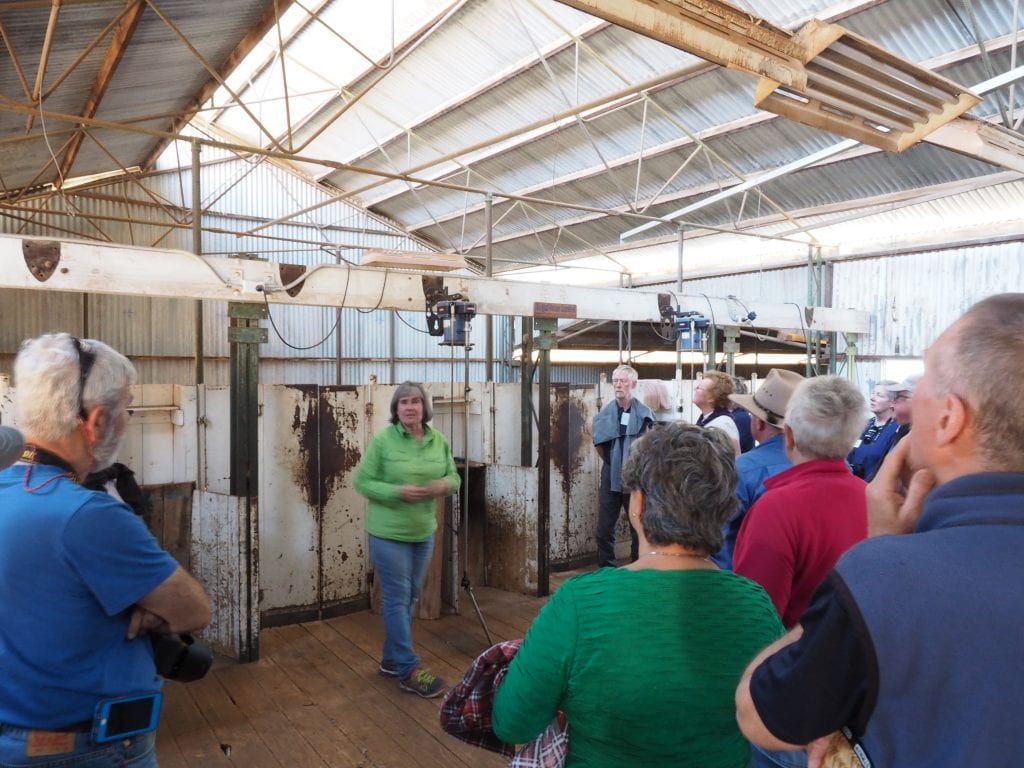
Our fourth transit was to Warraweena Sanctuary via the famous Prairie Hotel at Parachilna. It takes more than a few drops of rain to close a track but everyone was up early to meet our 0930 deadline at the Prairie Hotel for our Ediacaran Fossil Experience.
We were the last to get away from Alpana as Phil and Myrna’s LC200 experienced a mechanical moment. This ended up requiring a tilt tray to come up from Hawker and take it and their Matrix back so the car could be inspected and repaired. As they were planning on heading south after Farina they decided not to rejoin the group. By the time we got to Parachilna everyone was tucking into coffees and breakfasts and exploring the artwork around the pub.
The Ediacaran fossil site at Jane and Ross Fargher’s Nilpena Station is one of the most important in the world, representing the earliest evidence of complex life on earth. The site is of global significance and not open to the general public. The Ediacaran period is a globally recognised geological era from between
635–545 million years ago and named after the Ediacara hills of the Flinders Ranges. These fossil fields were included on the National Heritage list in 2007, are a subject of Sir David Attenborough’s First Life BBC series, and are a core aspect of the South Australian Government’s 2018 nomination of the Flinders Ranges for World Heritage listing. The group was fortunate to have Ross as our guide and we spent several hours being immersed not only in the history of the site and its global value but also learning how it was discovered by Ross and the challenges that had to be overcome over many years to finally be able to safely and securely open up the site to visitors.

Lunch at the Prairie Hotel is, in our experience, always memorable and this one was no different. Some took on the world-renowned FMG (feral mixed grill) and others sampled morsels from the grazing menu. After finishing off our meals with gelati in a cone nobody needed to think about dinner.
Because we had already aired down to drive safely from Alpana to the Prairie Hotel via Parachilna gorge, we were ready by mid-afternoon to drive the short bitumen leg to the turnoff, followed by 38 km or so of dusty, rocky track and through several creek crossings to Warraweena sanctuary and our campsite at Sliding Rock. Everyone arrived with daylight to spare and no issues with cars or campers. The dust sealing of both had been thoroughly tested with no failures found. Campfire lit, wine in hand, we gathered around to revisit what had been one of those more interesting days of travel.
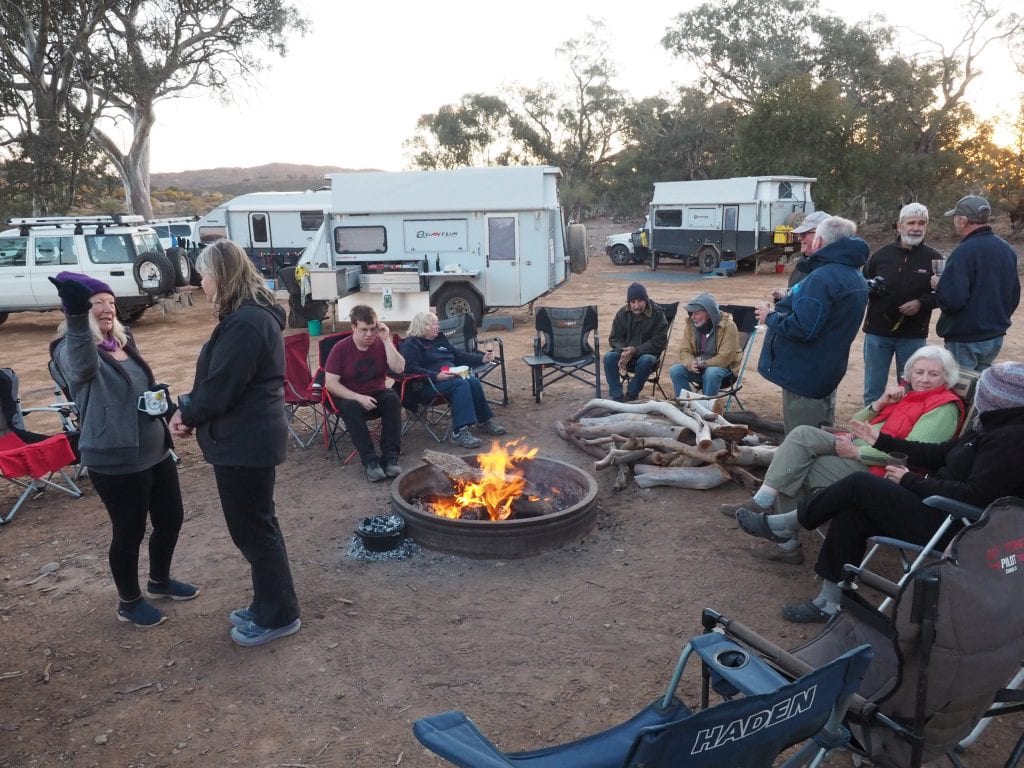
The next day we wound our way to the manager’s house to pay and get track notes before choosing our path for the day. Many took the opportunity to explore the historic tracks out to Mt Hack and the old Warraweena homestead while others explored the Sliding Rock mine site and surrounding creek lines. The class of 2018 photo was taken, using Ian and Madelaine Baker’s Matrix as the backdrop. Nobody had a drone so I used our squeezebox ladder to get high enough to fit everyone into shot, along with a wide-angle lens. Ross was awol to begin with and then Alex disappeared so one or the other may be missing from this photo! (Go to the end of this saga to see the class photo.) A fitting end to another great and different day.
The following day was a short one to the logistics hub of Leigh Creek. We had to get the group back to the bitumen early as there was a Bush Bash due to arrive. The thought of well over 60 vehicles heading towards us on the track we were heading out on was enough incentive to avoid them at all cost. The keen beans were packed and gone pretty early to avoid this travelling show. We ended up being tail-end Charlie again as a result of another ‘fail to proceed’ event where persons, who will not be named, left the keys in the ignition of their tow vehicle with the result that the battery had less than 7 volts in it when checked in the morning. Nothing was going to get it going as the voltage was too low so we hooked up the Yamaha for an hour and got it back to 12.7 volts. To the great relief of the owners the car started first time so they hit the track out quickly!
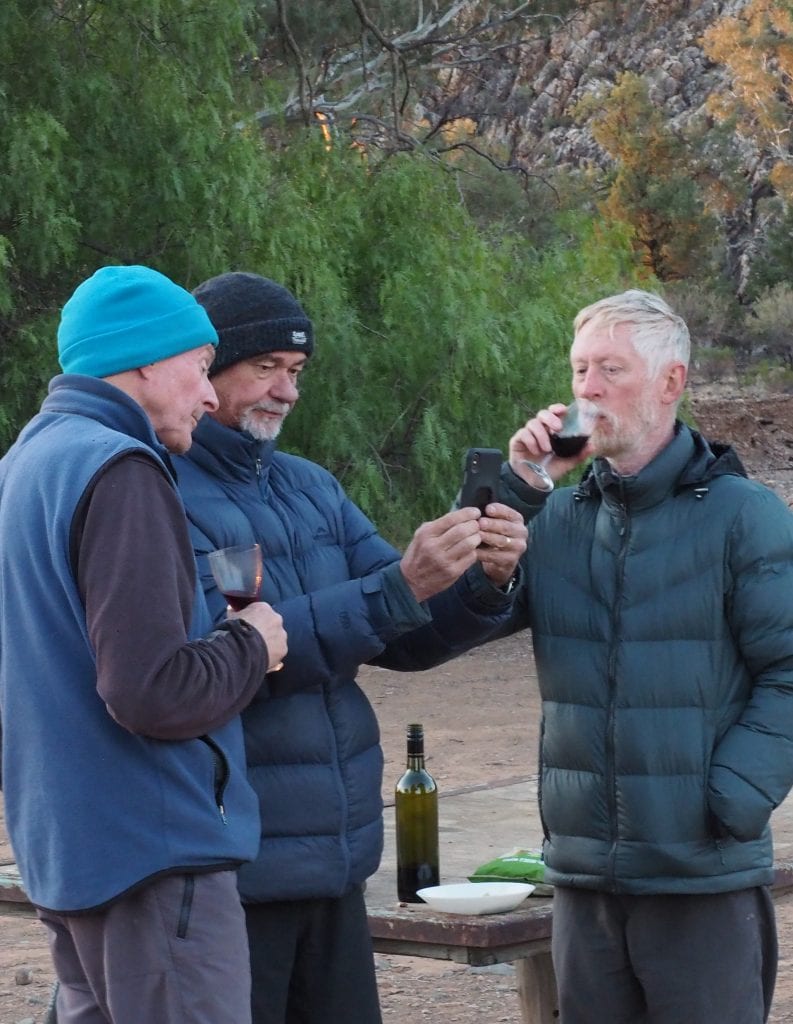
Leigh Creek, until a couple of years ago, was home to a large community supporting and operating the only brown coal open-cut mine in South Australia. The coal was carted by trains 2 km long to Port Augusta power station which supplied electricity to the state as our baseload generator. The closure of the mine reduced the population from a thousand or so to around 20. Uncertainty about a future is being slowly overcome with the purchase of the hotel and its gradual redevelopment, a supermarket, informative tourist centre staffed by a small group of volunteers, service station and small but well-managed and maintained caravan park. With it being conveniently located close to the start/end of the Strzelecki and Birdsville tracks, Leigh Creek has, and will remain, an excellent spot to empty black/grey tanks, top up water from an excellent supply source and restock food and beverages before heading north up the Oodnadatta track, or south to the Flinders Ranges or Port Augusta to turn east or west.
The benefits that a small group such as ours can have by supporting these small communities can be measured in many ways. Before heading to Farina we debriefed the progress group volunteers and found that our support had provided one of the best trading days they had experienced since the mine closed so please don’t drive past. Spend a day at least and support them and others like them.
Some birthdays were celebrated at the pub that night with cakes having been organised months prior. Washing was done, tanks emptied and filled as appropriate along with a general clean-up of owners and their equipment. The end result was the consensus that, despite travelling some interesting tracks, bugger-all had failed. Although there were still a few minor problems they were pretty much all fixed on the spot.
The final day of the rally was a short cruise from Leigh Creek to the historic ghost-town of Farina. The fascinating history of the place can be found here but the key to its popularity now has been the many years of patient and faithful restoration of some of the key elements of the town by the Farina Restoration Group, especially its now famous underground bakery. It also has a very nice campground but, given its huge popularity, it might be a place to avoid when the bakery is open in June and July if you’re not into crowds.
The short distance gave everyone plenty of time to explore Farina’s historic sites and settle in for drinks and nibbles around the fire while enjoying the improving (but still cold) weather pattern. Quite a relaxing end to what had been an excellent trip.
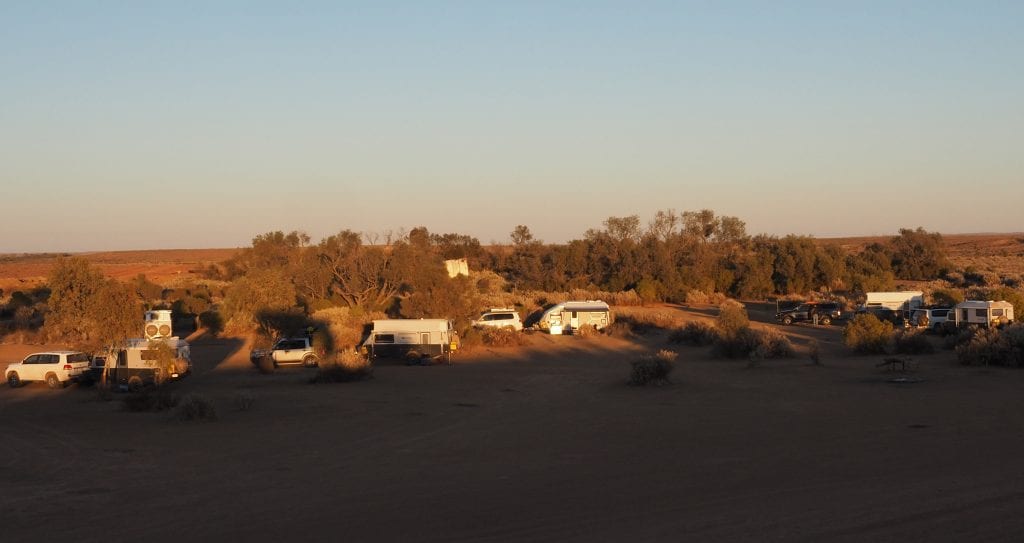
The following day half the group headed off on their own adventures while the rest joined us for another adventure travelling along the Oodnadatta track and old Ghan line to Alice Springs via Coward Springs, William Creek, Oodnadatta, the old Peake telegraph station ruins, Algebuckina bridge and waterhole, Eringa waterhole, Mt Dare, Finke and Chambers Pillar. But therein lies another story.
The class of 2018 (minus Ross, Phil and Myrna, and Rob taking the photo)
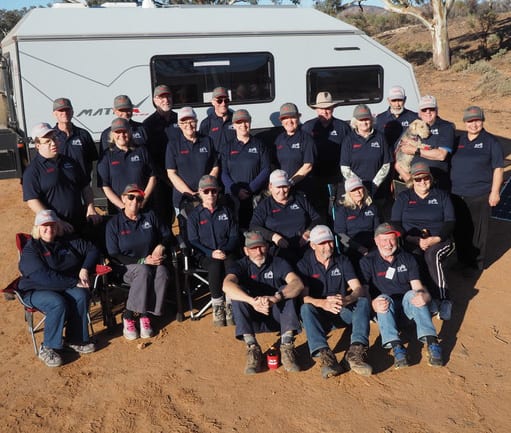
Dear motley crew
Thank you for putting your faith in us to take you on this interesting and enjoyable trip. We hope you all had a great time and we look forward to meeting you again sometime in the future. May all of your journeys be filled with adventure and exploration of new things!
By Rob & Pauline Ackland

